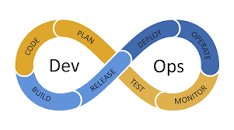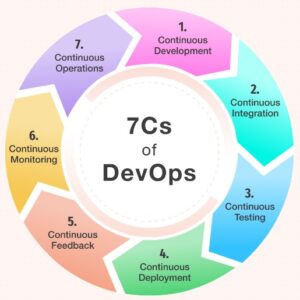Introduction
DevOps is a work culture that prioritizes collaboration, communication, and integration across development teams. It was created to bridge the gap between the development, operations, and quality assurance teams. As a result, businesses must implement DevOps practices for smooth software development and operations and high-quality deployment for effective product delivery. This article covers detailed knowledge of the DevOps Lifecycle.
Check Out Our DevOps Courses Now!
DevOps
Development and Operations, or DevOps, is a set of cultural concepts, practices, and practices that are intended to automate and streamline the software development and deployment process. It strongly emphasizes working together between development teams—who are in charge of developing software—and operations teams—who oversee and maintain IT infrastructure— to produce high-quality software more quickly and effectively. DevOps allows organizations to achieve shorter development cycles, quicker time-to-market, and increased software reliability by integrating automation, continuous integration, and continuous delivery (CI/CD) pipelines, and a robust feedback loop. Additionally, it encourages a culture of shared accountability, openness, and continual improvement, ultimately increasing contemporary firms’ responsiveness and competitiveness in a fast-changing digital environment.
What is the DevOps Lifecycle
The DevOps lifecycle is a collection of practices and processes that combine software development and IT operations to streamline and automate the software delivery pipeline.
It aims to reduce friction, improve collaboration, and accelerate software application development, deployment, and maintenance. The DevOps lifecycle typically consists of several interconnected phases, each with its objectives and activities.
Working on DevOps lifecycle
The DevOps lifecycle is designed to facilitate the efficient and collaborative development and deployment of software applications. It operates as a continuous loop, each phase feeding into the next and enabling rapid, reliable, and iterative software delivery. Here’s how the DevOps lifecycle works:
- Plan: In this initial phase, cross-functional teams collaborate to plan the software development process. This includes defining project goals, requirements, and priorities. Key activities include backlog grooming, sprint planning, and architectural design. The outcome is a well-defined plan that sets the stage for development.
- Code: Developers begin producing code based on the requirements and design once the plan is in place. This phase involves coding new features, fixing bugs, and making improvements. Collaboration is essential as developers work together and often use version control systems (e.g., Git) to manage code changes. Code quality and coding standards are upheld through code reviews and automated code analysis tools.
- Build: After code changes are committed, the build phase kicks in. Continuous Integration (CI) tools automate compiling, integrating, and packaging the code into deployable artifacts. Unit and integration tests are run automatically to detect integration difficulties and bugs early in the development cycle.
- Test: The testing phase is dedicated to ensuring the quality and reliability of the software. It encompasses a range of testing types, including unit testing, integration testing, functional testing, and performance testing. Automated testing tools help identify defects, validate functionality, and assess performance. Defects and issues in this phase are reported to the development team for resolution.
- Release: The Ops team will verify that the project is prepared for release during the release stage and integrate it into the live environment. This stage is crucial since it serves as the final check before deployment after several phases for vulnerabilities and defects.
- Deploy: With the software successfully passing the testing phase, it is ready for deployment. In this phase, Continuous Deployment (CD) or Continuous Delivery (also CD, but with a manual approval step) tools automate the deployment process to various environments, including staging and production. This automation ensures that deployments are consistent and can be rolled back if issues arise.
- Operate: Once in production, the software enters the operating phase. It is actively monitored and managed to ensure availability, performance, and security. Monitoring tools track vital metrics, and DevOps teams use this data to promptly identify and respond to issues. Activities in this phase include scaling, patching, and ongoing maintenance.
- Monitor and Optimize: The final phase involves continuous monitoring and optimization. Metrics and feedback collected from the production environment are analyzed to identify areas for improvement. This data-driven approach helps refine the software, enhance performance, and respond to changing user needs. Any issues or feature requests that arise are fed back into the planning phase to initiate the next development cycle.

The DevOps lifecycle is iterative and continuous, allowing teams to make incremental improvements with each cycle. This strategy encourages cooperation, automation, and transparency, allowing organizations to develop high-quality software more quickly and reliably. It also promotes a constant learning and growth culture, which is critical to the DevOps mindset.
DevOps Lifecycle Phases: the 7Cs of DevOps Lifecycle
The “7Cs of DevOps” is a helpful mnemonic to remember the key phases of the DevOps lifecycle. Each “C” represents a critical phase in the DevOps process:
- Continuous Development: This stage is crucial in defining the overall direction of the software development process. It is mostly concerned with project coding and planning. Project needs are obtained and addressed with stakeholders at this phase. In addition, the product backlog, which is divided into smaller releases and milestones for ongoing software development, is also kept up to date, depending on customer feedback.
- Continuous Integration: CI is crucial to the DevOps process. It entails developing and integrating code modifications into a shared repository daily. Automated testing is used to uncover integration issues early, ensuring the code is deployable.
- Continuous Testing: Continuous testing is an extension of CI, emphasizing the importance of automated testing throughout the DevOps lifecycle. Unit testing, integration testing, functional testing, and performance testing are all examples of testing. At each stage, the purpose is to confirm that the program meets quality criteria.
- Continuous Deployment: CD automates the deployment process, allowing for the rapid and consistent delivery of code changes to production or staging environments. Continuous Deployment tools ensure that deployments are reliable and can be rolled back if issues arise. There’s also a related concept called Continuous Delivery (CD), which includes manual approval before deploying to production.
- Continuous Feedback: Continuous feedback was created to evaluate and enhance the application code. In order to improve upcoming releases and deployments, consumer behavior is regularly assessed throughout this phase on each release. Businesses can choose an organized or unorganized method of collecting feedback. Surveys and questionnaires are used in the structural method to get feedback. On the other hand, social media platforms are used to collect feedback in an unstructured manner. Overall, the ability to release a better version of the application through continuous delivery is made feasible by this phase.
- Continuous Monitoring: Continuous monitoring is essential in the operating phase of the lifecycle. It involves actively monitoring the software in production environments. Monitoring tools track key performance metrics, detect anomalies, and provide real-time insights. This data helps teams proactively address issues and maintain system health.
- Continuous Operations: To minimize scheduled maintenance or other planned downtime, the DevOps lifecycle’s final stage is essential. The server must typically be offline for developers to perform the modifications, which lengthens the downtime and may possibly result in a large loss for the business. Continuous operation eventually automates the app’s start and updating procedures. To prevent downtime, Kubernetes and Docker are used as container management solutions. The process of developing, testing, and deploying the application across many environments is made simpler by these container management solutions. The main goal of this stage is to increase the application’s uptime in order to maintain uninterrupted services. Developers can speed up the time it takes for an application to reach the market by saving time through continuous operations.

Organizations may build a culture of collaboration, automation, and continuous improvement by adhering to the 7Cs of DevOps, allowing them to deliver high-quality software more efficiently and effectively. These interconnected and iterative phases allow for rapid and reliable software delivery while encouraging teams to learn from their experiences and adapt to evolving needs.
Conclusion
Organizations can reap multiple benefits by adopting the DevOps lifecycle, including faster software delivery, more collaboration, higher quality, more excellent reliability, and cost savings. Furthermore, DevOps promotes a culture of continuous learning and adaptation, allowing firms to remain competitive and responsive to changing market needs. Adopting this comprehensive software development and operations approach is critical to surviving today’s dynamic and fast-paced technology landscape.
DevOps has built a new culture in the software development business by maintaining the highest quality standards for software products. The DevOps lifecycle’s major purpose is to maintain continuity while optimizing automation.
It all comes down to how well the developers, testers, and operations teams communicate to deliver the software product on time and with a better user experience.








